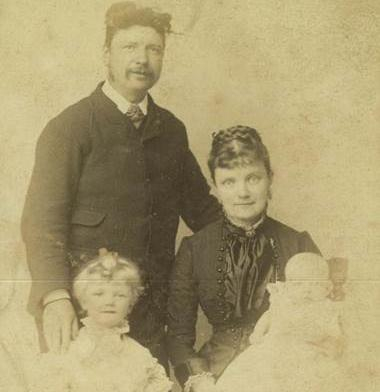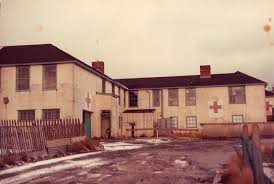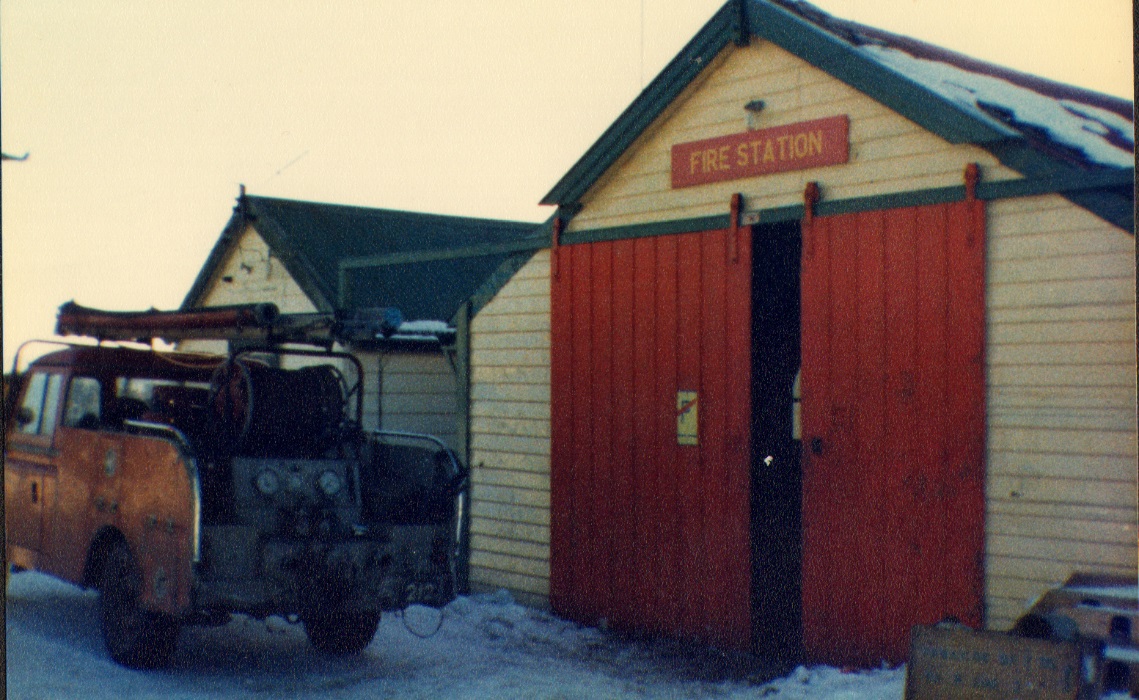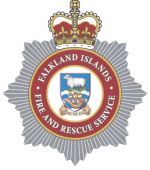History
Note: This article has been written from reports of these incidents and establishment changes in local gazettes and news articles. These are just summaries of events and as such do not go into great detail about any incident. Many services will have been involved in these incidents alongside fire and rescue and their roles are greatly appreciated. This article mostly focuses on the fire department’s role in these incidents as a matter of recording some of the fire department’s history. This article wouldn’t have been possible with the access of articles from the Jane Cameron National Archives. All information sources listed were found on their website. Also a huge thankyou to the Falkland Islands Museum and National Trust for providing most of the photographs.

|
Figure 1 Original Notice Calling for Firefighters 1898 |
1898 - The history of the Falkland Islands Fire & Rescue Department starts with the formation of the Falkland Islands Volunteer Fire Brigade on the 24th March 1898. On this date a public meeting was held asking anyone interested in forming a volunteer fire brigade please attend by request of Colonial Secretary F. Craigie-Halkett.
At this meeting 29 men offered themselves ready and willing to man the recently imported fire engine. On this day without hesitation the 29 men were sworn in promising that “they would be faithful and bear true allegiance to Her Majesty the Queen and that they would faithfully serve and carry out to the best of their ability, and for the best interests of their fellow, all the duties required of them as members of the fire brigade”(Falkland Islands Magazine, May 1898). By March 31st 1898 the governor notified for general information that he accepted the services of those attending the public meeting signifying their desire to be formed into a volunteer fire brigade. He declared the fire brigade lawfully formed designating them as the “Stanley Volunteer Fire Brigade”.
The following men became the Falkland’s first firefighters:

|
Figure 2 The list of the Falklands first firefighters (Falklands Gazette) |
Many of our current firefighters are direct descendants to these men. On the 1st of April a vote was held to select the officers for 6 new positions as follows:
Superintendent Serjeant Davies
Inspector Mr W Ryan
Assistant Inspector J Steele
Engineer J Kelway
Assistant Engineer J McAtasney
Secretary F Durose
At this time Stanley Volunteer Fire Brigade’s main piece of equipment was their Merryweather & Sons Double Cylinder vertical steam fire engine. Designed to be pulled by hand, the new engine was capable of delivering 360 gallons of water per minute. The engine was coal powered steam, which could be stoked while travelling and generate 100lbs of pressures from cold water in 8 minutes.

|
Figure 3 Double cylinder vertical steam engine (Falklands Gazette) |
After this there is very little literature on the activity of the Stanley Volunteer Brigade. From reading the old church magazines post 1898, it appears they would have been extremely busy with chimney fires.
An article in the Falkland Island magazines describes one of the first drill nights in some detail which make for some interesting reading. We include the following passage for interest:
“Several meetings for drill have been held and the scene of activity at the Custom House when the drills are held is really inspiriting: with such alacrity do the men take up their stations, some to the drag ropes, some to the supply pipe, some to the hose carts, some to the water and coal supply carts, some to the fire escape ladders, others to the nozzles, and rapidly everything is in correct order for putting out the biggest fire that is likely to roar in Stanley. Again comes the word of command “Return Stores” and hey presto everything is back in its place in a twinkling.” (F, Durose. Falklands Magazine, May 1898)
The Honorable Secretary, F Durose, went on to talk about his pride and hopes for the Stanley Volunteer Fire Brigade making the following statement about the work:
“We will do it quite willingly and even stand being laughed at for our folly, however it is preferable to be laughed at for doing unselfish work than admired for mean stand-by-and-let-other-people-do-the-work-isness”

| Mr Fredrick Durose and family (Jane Cameron National Archives) |
There is very little record of the Fire Brigade in most available publications apart from changes of Superintendent and accounts records until 1921 when some rules for volunteers are published in the gazette outlining expectations of volunteers.

|
Figure 4 New rules for fire brigade members 1921(Falkland Gazette) |
1911 - On March 11th 1911 the Stanley Volunteer Fire Brigade experienced one of its first recorded big fires at the Assembly Rooms. The fire originated in a nearby house, quickly spreading to the Assembly Rooms, which were completely destroyed. The fire was then threatening to take the Government Offices but was thwarted by the work of the Stanley Volunteer Fire Brigade and their steam fire engine. (1911, FI Magazine and Church Paper)

|
Figure 5 Aftermath of Assembly Rooms Fire, 1911 (FIMNT) |
Most of the fires recorded during the 1900s were chimney fires. Sometimes these were repeatedly at the same addresses due to lack of maintenance of chimneys by their owners. Most were brought under control before any serious damage could occur.
1935 - In 1935 the Colonial Police and Fire Brigades Long Service medal was introduced to the Falklands and was rewarded in the case of 18 years continuous service. Over the years this has been reduced to 10 years, receiving a bar at 15 years.
1944 - 1944 brought another major incident for the Stanley Volunteer Fire Brigade with the burning down of the town hall. Early in the morning on Sunday the 16th of April 1944 a fire broke out in the upper storey of the town hall. The firefighting services were on scene within minutes and despite there being little wind were unable to keep the fire under control. The Falkland Islands Weekly News reported” The building being constructed mostly of wood and being of such a great size burnt like a torch and the speed of the flames was so rapid that they could not possibly be held. The Fire Services were, however, able to save St Mary’s chapel, the gymnasium and the power house” (April 1944, The Falkland Islands Weekly News). The town hall at the time held many government records and offices, very little was salvageable.

|
Figure 6 Original Town Hall (FIMNT) |

|
Figure 7 Town Hall Fire 1944 |
There is very little change in the Fire Service from its original format until 1973. In this year changes were made to the Stanley Town Public Services Ordinance. The Stanley Town Council was dissolved during this year causing some confusion as to who was responsible for the Brigade.
1982 was a difficult time for everyone in the Falklands. The Stanley Volunteer Fire Brigade did its best to continue serving during the conflict and was kept quite busy throughout the whole period. Neville Bennett was the superintendent at the time and he put out a call for more volunteers which was readily answered by members of the community. The new volunteers required some training and for some time training was allowed to continue. However at the time it was not unusual for firefighters to carry tin snips due to many houses favouring tin cladding. After several suspicious incidents where Argentine phone lines kept losing connection, the Fire Brigade were no longer allowed to train outside for the remainder of the conflict.
The Fire Brigade was particularly busy during the last days of the conflict. 18 buildings were damaged or destroyed during the final days. Firefighters attended as many as possible though by the time one fire was out often another would be well developed elsewhere. There are not many recorded accounts of the fires that day apart from the Globe Store. One account talks about the difficulties of fighting this fire whilst the final battles of the war took place such as disgruntled soldiers piercing the hoses as the brigade tried to save what they could. There’s very few records of who the firemen were but their bravery in the face of wartime will not be forgotten.

|
Figure 8 Globe Store Fire |
Post conflict the Fire Brigade was still in operation. They received guidance, training and assistance from RAF Stanley until the opening of Mount Pleasant International Airport and Military Base in 1985.
1984 – On the 10th of April 1984 one of the most tragic major incidents to occur in islands shocked the country culminating in the loss of 8 people and 2 seriously injured. At 04:45 that morning a fire broke out in the oldest section of the hospital constructed almost entirely of timber. With vast amounts of fuel, the fire ripped through the building with terrifying speed. Staff rushed quickly and valiantly to evacuate their patients before the smoke became too thick. Some more able patients managed to escape through windows as the smoke travelled through the building extremely quickly. Upon arriving firefighters entered the building using breathing apparatus to search for survivors. Penguin News at the time reported that “The towns friendly senior Catholic priest, Monsignor Daniel Spraggon, had been feared dead, but firemen with breathing apparatus were amazed to find him still breathing in his Churchill Wing ward a considerable time after the fire had broken out.” (Penguin News, April 1984)
Military and civilian firefighters both answered the call to the hospital, arriving on site within 5 minutes. Firefighters, hospital staff and bystanders worked to put out the fire, evacuate patients and set up temporary medical facilities for the displaced patients. The community pulled together to make sure patients needs were met as much as possible.
The hospital fire coming right on the heels of the Falklands Conflict was a huge blow to the community. 8 souls lost including a new mother and baby who will never be forgotten. The hospital fire not only changed the lives of Falkland Islanders but also went on to influence fire investigation policy. (Fire, April 1988).

|
Figure 9 Original hospital |
1985 – On the 7th of January 1985 the Superintendent’s position was made into a full time post reporting to the Director of Public Works. This was the first step in the Fire Brigade becoming a more recognisable establishment.
1986 – In this year the Fire Brigade broke away from the Public Works Department and became Police, Fire and Rescue. More full time positions were appointed with the addition of a leading fireman with mechanical experience, a sub officer and then later on a fireman/handyman.
Later that year the Fire Service became its own stand alone department and moved to St Mary’s Walk. At this point it changed its name again to what it is know today:
The Falkland Islands Fire and Rescue Service
At this point the position of Superintendent was changed to Chief Fire Officer.

|
Figure 10 The old fire station |
1987 – 1987 saw a major fire in Stanley breaking out on Boxing Day. At 20:53 on the 26th December 1987 the alarm was raised as the Admiralty Cottages were spotted on fire. The Penguin News at the time reported that “The appliances had arrived just before 9pm and teams of firefighters using breathing apparatus set about fighting the blaze which was concentrated in the south end and adjoining flat.” The main fire was brought under control within 15 minutes. Though the south end of the cottages was completely gutted by fire, BA teams had to work hard to stop the fire spreading though the loft which was reported to at one point have fireball down the length roof and could have easily taken the other end of the building.
1988 – A mere two weeks after fighting the Admiralty Cottages firemen were called out to another major incident. At 2am on the 11th of January 1988 a fire broke out in the building known as “ The Gluepot”. Persons had been reported in the building as well as risk of fire spreading to adjacent buildings. The Penguin News reported “The seat of the fire was in the Kitchen/ living room in the south east corner of the building and three teams of firemen using breathing apparatus fought the flames bringing the fire under control in 20 minutes and the blaze was extinguished by 3:30am.” Two people had been in the building at the time of the fire. One had managed to escape through a window. The other unfortunately was overcome by smoke and had been unable to escape. 18 year old Jason Wingate sadly passed away during the incident. Our thoughts are with his family.
Though between the appliances and bowsers at the scene there was over 4300 gallons of water, this incident did highlight the need for more hydrants at the time. Motions were put forth following this incident to increase the number of hydrants available.
1989 – It seems that during this period a number of major incidents occurred devastating our community. On the 20th of May 1989 another tragic event came in the form of a ship fire. The fire had broken out on board the stern trawler Frio Pesca Uno which had been towed to Stanley to be dealt with by the Fire and Rescue Service. During the battle two young firefighters had become lost within the vessel using breathing apparatus whilst searching for survivors. They never found their way out and tragically lost their lives. The two young men were Gerard Johnson and Robert Finlayson. They will never be forgotten and our thoughts are always with their families.
1990 – Some establishment changes were made. Volunteer firemen became retained firefighters. Total numbers of retained have remained about 40 members, the same as 121 years ago.
As well as domestic fires, the fire service also deals with camp fires. During the dry summer months the grass lands and peat soil make perfect fuel for wild fires to get out of control. The peat underneath can allow these fires to burn for months, destroying thousands of acres and changing direction as quickly as the wind. The fire department has fought many large camp fires over the years alongside both farmers and military.

